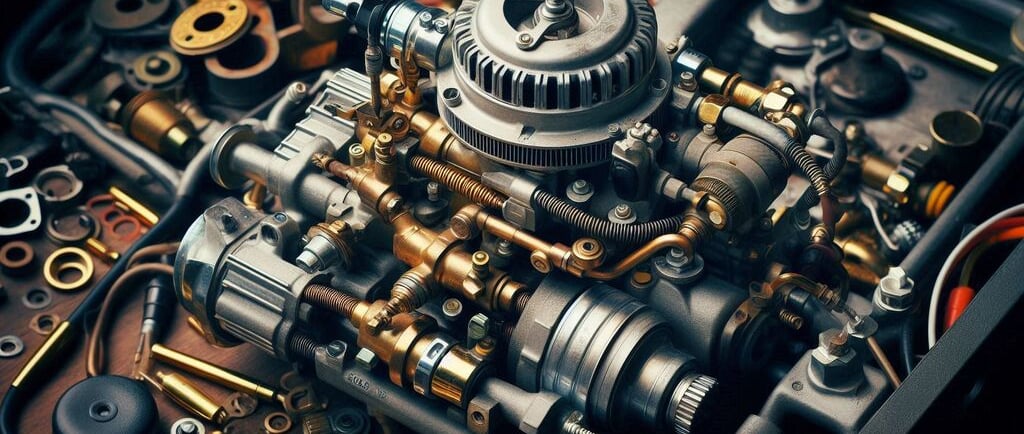Carburetor (older vehicles) Mixes fuel with air in proper ratios.
If you're a fan of classic cars or just interested in how older vehicle engines work, you’ve likely heard of the carburetor.
FUEL SYSTEMS
11/13/20244 min read


Carburetors in Older Vehicles: Mixing Fuel and Air for Optimal Performance
If you're a fan of classic cars or just interested in how older vehicle engines work, you’ve likely heard of the carburetor. This small but essential device is the heart of fuel delivery in vintage cars, carefully mixing fuel with air in precise ratios to power the engine. While modern vehicles use fuel injectors, carburetors were once standard and are still found in many older and classic cars. Here, we’ll cover everything you need to know about carburetors, from how they work to how to maintain them for optimal performance.
What is a Carburetor?
The Basics of a Carburetor
A carburetor is a mechanical device designed to mix fuel with air in the right proportions for combustion. Located on top of the engine in older vehicles, it draws in air from the environment, adds the appropriate amount of fuel, and delivers this mixture to the engine’s cylinders, where it’s ignited to produce power.
Why Carburetors Were Essential in Older Vehicles
Carburetors served as the main method of fuel delivery in cars for decades, from the early 1900s until the late 1980s when electronic fuel injection systems became more popular. Fuel injection is more efficient and easier to control electronically, but carburetors still remain a beloved component in classic car culture, as they allow for more manual tuning and control.
How Does a Carburetor Work?
Step-by-Step Function of a Carburetor
Air Intake
The carburetor begins by drawing in air through a filter to ensure that no dust or debris enters the engine. This filtered air then flows into the carburetor.Fuel Mixing
As air enters, it passes through a narrowed section called the venturi. This area creates low pressure, drawing fuel from a chamber within the carburetor into the airstream.Adjusting the Mixture
The carburetor adjusts the fuel-to-air ratio based on the engine's needs. At idle or low speeds, it mixes less fuel; at higher speeds, it increases fuel flow to match the air intake, ensuring optimal power.Delivering the Mixture to the Engine
Once mixed, the fuel and air combination is delivered to the engine cylinders for combustion, where it ignites and powers the engine.
This straightforward, mechanical approach to fuel mixing allowed vehicles to run efficiently before the days of complex electronics.
Key Parts of a Carburetor
Venturi: The narrow section that creates low pressure to pull fuel into the air.
Throttle Plate: Controls the amount of air entering the carburetor, which directly affects speed and power.
Float Chamber: A reservoir that maintains a steady fuel level inside the carburetor.
Each of these parts plays an essential role in ensuring that the carburetor provides the right fuel-to-air ratio.
Common Carburetor Issues and How to Fix Them
Carburetors require regular maintenance, especially in classic cars. Here are some common issues and tips for keeping your carburetor in good condition:
1. Engine Stalling or Rough Idling
If your engine stalls frequently or idles roughly, it may be due to a clogged jet or an improper fuel-to-air mixture. Cleaning the jets with a carburetor cleaner can help restore smooth idling. Regular cleaning will prevent dirt and debris from blocking the fuel flow.
2. Poor Fuel Efficiency
If you’re noticing higher fuel consumption than usual, it could indicate a carburetor issue, often caused by an overly rich fuel mixture. Adjusting the carburetor to a leaner setting can improve fuel economy. However, it’s important to consult a mechanic if you’re not experienced, as improper adjustments can harm performance.
3. Difficulty Starting the Engine
Starting problems often stem from fuel delivery issues, which can sometimes be solved by adjusting the choke. The choke limits air intake to allow more fuel into the engine, making it easier to start a cold engine. A faulty or misadjusted choke might need a quick repair to get back to smooth starts.
Tips for Carburetor Maintenance
Use High-Quality Fuel: Low-grade fuels can contain contaminants that clog the carburetor, so using quality fuel is essential for long-term performance.
Regularly Inspect for Leaks: Carburetors contain seals and gaskets that may wear down over time. Regular inspections will help you catch leaks early before they cause larger issues.
Clean the Carburetor Periodically: Over time, dirt and grime build up within the carburetor. Using a dedicated carburetor cleaner can keep it running smoothly.
Why Carburetors Remain Popular Among Classic Car Enthusiasts
Even though most new vehicles come with electronic fuel injection systems, carburetors are still popular among classic car enthusiasts. Here’s why:
Easier to Repair: Carburetors are simpler than modern fuel injection systems and can often be fixed with basic tools, making them accessible for at-home mechanics.
Tuning Flexibility: With a carburetor, drivers can manually adjust fuel and air flow to suit their performance needs, allowing for custom tuning in a way that fuel injectors do not.
Nostalgia: For classic car fans, carburetors represent an era when vehicles were more mechanical and less dependent on electronics, adding to the driving experience.
Whether you’re restoring a classic car or simply appreciate older technology, learning how to maintain and repair a carburetor can be both rewarding and useful.
Conclusion: Mastering the Carburetor for Optimal Performance
Carburetors may seem old-fashioned, but they continue to be vital for many classic vehicles. Understanding how they work, how to maintain them, and how to troubleshoot common problems can help you keep an older vehicle running smoothly for years to come. Regular maintenance, like cleaning and tuning, can also enhance your car's performance, ensuring it remains fuel-efficient and reliable.



